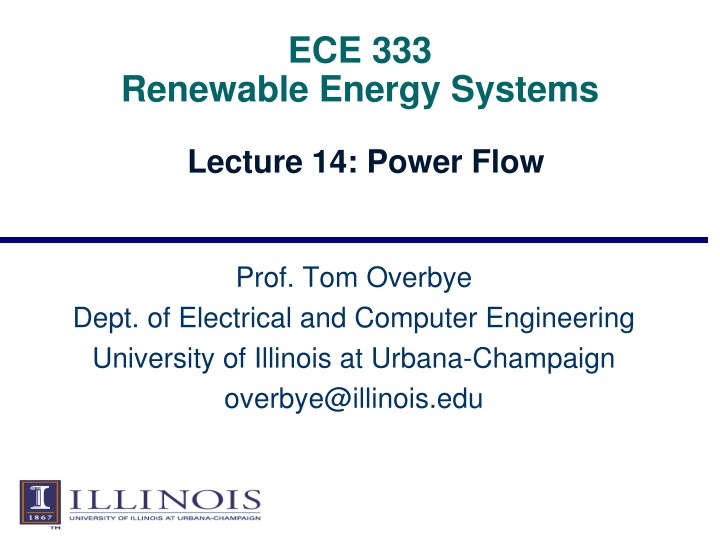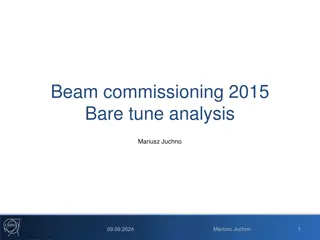
Bus Admittance Matrix and Ybus in Power Flow Analysis
Learn about the crucial concepts of the bus admittance matrix (Ybus) in power flow analysis. Discover how it establishes relationships between bus current injections and voltages, aiding in the efficient analysis of power systems. Dive into examples and the general form of Ybus to enhance your understanding.
Download Presentation

Please find below an Image/Link to download the presentation.
The content on the website is provided AS IS for your information and personal use only. It may not be sold, licensed, or shared on other websites without obtaining consent from the author. If you encounter any issues during the download, it is possible that the publisher has removed the file from their server.
You are allowed to download the files provided on this website for personal or commercial use, subject to the condition that they are used lawfully. All files are the property of their respective owners.
The content on the website is provided AS IS for your information and personal use only. It may not be sold, licensed, or shared on other websites without obtaining consent from the author.
E N D
Presentation Transcript
ECE 333 Renewable Energy Systems Lecture 14: Power Flow Prof. Tom Overbye Dept. of Electrical and Computer Engineering University of Illinois at Urbana-Champaign overbye@illinois.edu
Announcements Power flow is only covered in lecture; not in the book No quiz today HW 6 is posted on the website and is due on Thursday March 19. HW 6 must be turned in and will count the same as a quiz. There will be no quiz on March 19. Start Reading Chapter 4 (The Solar Resource) 1
Bus Admittance Matrix or Ybus First step in solving the power flow is to create what is known as the bus admittance matrix, often call the Ybus. The Ybus gives the relationships between all the bus current injections, I, and all the bus voltages, V, I = YbusV The Ybus is developed by applying KCL at each bus in the system to relate the bus current injections, the bus voltages, and the branch impedances and admittances 2
Ybus Example Determine the bus admittance matrix for the network shown below, assuming the current injection at each bus i is Ii = IGi - IDi where IGi is the current injection into the bus from the generator and IDi is the current flowing into the load 3
YbusExample, contd By KCL at bus 1 we have I I I 1 1 1 G D V V V V 1 2 1 3 = + = + I 12 I 13 I 1 Z Z A B 1 = + = ( ) ( ) (with Y ) I V V Y V V Y 1 1 2 1 3 j A B Z j = + ( ) Y Y V Y V Y V 1 2 3 A B A B Similarly I = = + + I I I 2 21 Y V 23 + 24 + + ( ) Y Y Y V Y V Y V 1 2 3 4 A A C D C D 4
YbusExample, contd We can get similar relationships for buses 3 and 4 The results can then be expressed in matrix form = + + = I Y V bus Y 0 Y I I I I Y Y Y Y + V V V V 1 1 A B A B + Y Y Y Y Y 2 2 A A C Y Y D C Y D 0 Y 3 3 B C B C 0 0 Y 4 4 D D For a system with n buses, Ybus is an n by n symmetric matrix (i.e., one where Aij = Aji) 5
Ybus General Form The diagonal terms, Yii, are the self admittance terms, equal to the sum of the admittances of all devices incident to bus i. The off-diagonal terms, Yij, are equal to the negative of the sum of the admittances joining the two buses. With large systems Ybus is a sparse matrix (that is, most entries are zero) 6
Power Flow Analysis When analyzing power systems we know neither the complex bus voltages nor the complex current injections Rather, we know the complex power being consumed by the load, and the power being injected by the generators plus their voltage magnitudes Therefore we can not directly use the Ybus equations, but rather must use the power balance equations 7
Power Flow Slack Bus We can not arbitrarily specify S at all buses because total generation must equal total load + total losses We also need an angle reference bus. To solve these problems we define one bus as the "slack" bus. This bus has a fixed voltage magnitude and angle, and a varying real/reactive power injection. A slack bus does not exist in the real power system. 8
Power Balance Equations From KCL we know at each bus i in an n bus system the current injection, , must be equal to the current that flows into the network I i n = = I I I I i Gi Di ik = 1 k I Y V Since = we also know bus n = = I I I ik k Y V i Gi Di = 1 k * = The network power injection is then S V I i i i 9
Power Balance Equations, contd * n n * * * = = = S V I V ik k Y V V ik k Y V i i i i i = = 1 1 k k This is an equation with complex numbers. Sometimes we would like an equivalent set of real power equations. These can be derived by defining Y G jB + ik ik ik j = V V e V i i i i i ik i k j = + Recall e cos sin j 10
Real Power Balance Equations n n j * * = + = = S ( ) P jQ V ik k Y V V V e G jB ik i i i i i k ik ik = = 1 1 k k n = + (cos sin )( ) V V j G jB i k ik ik ik ik = 1 k Resolving into the real and imaginary parts n = + = P ( cos sin ) V V G B P P i i k ik ik ik ik Gi Di = 1 k n = = Q ( sin cos ) V V G B Q Q i i k ik ik ik i k Gi Di = 1 k 11
Newton-Raphson Method (scalar) General form of problem: Find an x such that ( ) 0 f x = ( ) v 1. For each guess of , , define x x ( ) v ( ) v = - x x x 2. Represent ( ) by a Taylor series about ( ) f x f x ( ) v ( dx ) df x ( ) v ( ) v = + + ( ) f x ( ) f x x 2 ( ) v ( ) 1 2 ( ) d f x dx 2 ( ) v + + higher order terms x 2 12
Newton-Raphson Method, contd 3. Approximate ( ) by neglecting all terms except the first two f x ( ) v ( dx ) df x ( ) v ( ) v = + ( ) f x 0 ( ) f x x ( ) v 4. Use this linear approximation to solve for x 1 ( ) v ( dx ) df x ( ) v ( ) v = ( ) x f x 5. Solve for a new estim + = ate of x ( 1) ( ) v ( ) v v + x x x 13
Newton-Raphson Example 2 = = Use Newton-Raphson to solve ( ) The equation we must iteratively solve is -2 0 f x x 1 ( ) v ( dx ) df x ( ) v ( ) v = ( ) x f x 1 x + ( ) v ( ) 2 v = (( ) -2) x x ( ) v 2 + ( 1) ( ) v ( ) v v = x x x 1 x + ( 1) ( ) v ( ) 2 v v = (( ) -2) x x x ( ) v 2 14
Newton-Raphson Example, contd 1 x + ( 1) ( ) v ( ) 2 v v = (( ) -2) x x x ( ) v 2 (0) = Guess x 1. Iteratively solving we get ( ) v ( ) v ( ) v v 0 1 ( 1 ) x f x x 1 1.5 0.5 0.08333 0.25 3 3 2.454 10 2 1.41667 6.953 10 6 3 1.41422 6.024 10 15
Newton-Raphson Comments When close to the solution the error decreases quite quickly -- method has quadratic convergence f(x(v)) is known as the mismatch, which we would like to drive to zero Stopping criteria is when f(x(v)) < Results are dependent upon the initial guess. What if we had guessed x(0) = 0, or x (0) = -1? A solution s region of attraction (ROA) is the set of initial guesses that converge to the particular solution. The ROA is often hard to determine 16
Multi-Variable Newton-Raphson x Next we generalize to the case where is an n- dimension vector, and ( ) is an n-dimension function x x = x x x x f x x ( ) ( ) x f f 1 1 2 2 = x ( ) f x x ( ) = x f n n f x Again define the solution so ( ) = 0 and 17
Multi-Variable Case, contd x The Taylor series expansion is written for each f ( ) f ( ) f ( ) f ( ) x + i x x f ( ) x 1 1 = + + + x x x x 1 1 1 2 1 2 x f ( ) x 1 higher order terms x n n x x f ( ) x f ( ) x n n = + + + x x f ( ) f ( ) x x n n 1 2 1 2 x f ( ) x n + higher order terms x n n 18
Multi-Variable Case, contd This can be written more compactly in matrix form ( ) f x f f f x = + higher order terms + x x x ( ) x ( ) x f f 1 1 1 1 x 2 x n x x ( ) ( ) x x x 1 1 ( ) ( ) x ( ) x f f 2 2 2 2 2 ( ) f x 1 2 n n x ( ) x f n x x x ( ) x ( ) x ( ) x f f f n n n 1 2 n 19
Jacobian Matrix The n by n matrix of partial derivatives is known as the Jacobian matrix, ( ) ( ) f f x f f x = J x x x x ( ) x ( ) x f 1 1 1 1 x 2 x n x ( ) ( ) x ( ) x f 2 2 2 ( ) J x 1 2 n x x x ( ) x ( ) x ( ) x f f f n n n 1 2 n 20
Multi-Variable N-R Procedure Derivation of N-R method is similar to the scalar case ( ) ( ) ( ) ( ) 0 ( ) x J x f x = = + + + f x f x f x J x f x x higher order terms ( ) J x x 1 ( ) ( ) + ( 1) ( ) v ( ) v v = + x x x + ( 1) ( ) v ( ) v 1 ( ) v v = x x J x f x ( ) ( ) ( ) v f x Iterate until ( ) 21
Multi-Variable Example x x 1 = x f x Solve for = such that ( ) 0 where 2 x 2 1 2 1 x 2 2 = + = x f ( ) 2 8 0 x 1 2 2 = + = x f ( ) 4 0 x 1 2 x x 2 First symbolically determine the Jacobian f ( ) x x x f ( ) x 1 1 1 2 ( ) = J x x x f ( ) x f ( ) x 2 2 1 2 22
Multi-variable Example, contd 4 2 x + x 1 2 2 ( ) = J x 2 x x x x 1 2 1 2 Then 1 x 4 2 ( ) ( ) x x x x + x f f 1 1 2 2 1 = 2 x x x x 2 1 2 1 2 2 1 1 (0) = x Arbitrarily guess 1 1 1 4 3 2 5 3 2.1 1.3 (1) = = x 1 23
Multi-variable Example, contd 1 2.1 1.3 8.40 5.50 2.60 0.50 f x 2.51 1.45 1.8284 1.2122 (2) = = x Each iteration we check ( ) to see if it is below our specified tolerance 0.1556 ( ) 0.0900 If = 0.2 then we wou ld be done. Otherwise we'd continue iterating. (2) = f x 24
Newton-Raphson Power Flow In the Newton-Raphson power flow we use Newton's method to determine the voltage magnitude and angle at each bus in the power system. We need to solve the power balance equations n = + = P ( cos sin ) V V G B P P i i k ik ik ik ik Gi Di = n 1 k = = Q ( sin cos ) V V G B Q Q i i k ik ik ik ik Gi Di = 1 k
Power Flow Variables Assume the slack bus is the first bus (with a fixed voltage angle/magnitude). We then need to determine the voltage angle/magnitude at the other buses. = + ( ) x P P P 2 2 2 2 G D + + x ( ) ( ) x P Gn P Q P Q n n Dn = x ( ) f x V Q 2 2 2 2 G D + ( ) x V Q Q Q n n Gn Dn
N-R Power Flow Solution The power flow is solved using the same procedure discussed last time: ( ) v = x x Set 0; make an initial guess of , v ( ) v f x While ( ) Do + ( 1) ( ) v ( ) v 1 ( ) v v = = x x J x f x ( ) ( ) + 1 v v End While
Power Flow Jacobian Matrix The most difficult part of the algorithm is determining and inverting the n by n Jacobian matrix, ( ) ( ) ( ) f f x x f f x x = J x J x x x x ( ) x f 1 1 1 1 x 2 x n x ( ) ( ) ( ) x f 2 2 2 ( ) 1 2 n x x x ( ) x ( ) x ( ) x f f f n n n 1 2 n
Power Flow Jacobian Matrix, contd Jacobian elements are calculated by differentiating each function, f ( ), with respect to each variable. For example, if f ( ) is the bus i real power equation x x i i n = + + f ( ) ( cos sin ) x V V G B P P i i k ik ik ik ik Gi Di = n 1 k f ( ) x i = + ( sin cos ) V V G B i k ik ik ik ik = i 1 k k i f ( ) x i = ( sin cos ) ( ) V V G B j i i j ik ik ik ik j
Two Bus Newton-Raphson Example For the two bus power system shown below, use the Newton-Raphson power flow to determine the voltage magnitude and angle at bus two. Assume that bus one is the slack and SBase = 100 MVA. Line Z = 0.1j One 1.000 pu Two 1.000 pu 0 MW 0 MVR 200 MW 100 MVR 10 10 j 10 10 j j j 2 = = x Y bus V 2
Two Bus Example, contd General power balance equations n = + = P ( cos sin ) V V G B P P i i k ik ik ik ik Gi Di = 1 k n = = Q ( sin cos ) V V G B Q Q i i k ik ik ik ik Gi Di = 1 k Bus two power balance equations (10sin V V ) 2.0 + = 0 2 1 2 2 ( 10cos + (10) 1.0 + = ) 0 V V V 2 1 2 2
Two Bus Example, contd = ) 2.0 + = x P ( ) (10sin 0 V 2 2 2 2 = ( 10cos + (10) 1.0 + = ( ) x ) 0 Q V V 2 2 2 2 Now calculate the power flow Jacobian P ( ) = = P ( ) x x 2 2 V 2 2 x ( ) x J x Q ( ) Q ( ) 2 2 V 2 2 + 10 10 cos sin 10sin V V 2 2 2 20 10cos V 2 2 2 2
Two Bus Example, First Iteration 0 1 (0) = = x Set 0, guess v Calculate ) 2.0 + (10sin V 2.0 1.0 2 2 V (0) = = x f( ) 2 ( 10cos + + ) (10) 1.0 + V 2 2 2 10sin 10 10 cos sin V V 10 0 0 2 2 2 20 (0) = = J x ( ) 10cos V 10 2 2 2 2 12.0 1.0 0 1 10 0 0 0.2 0.9 (1) = = x Solve 10
Two Bus Example, Next Iterations 0.9(10sin( 0.2)) 2.0 + 0.212 0.279 (1) = = x f( ) 2 + 10 1.0 + 0.9( 10cos( 0.2)) 8.82 1.788 0.9 1.986 8.199 (1) = J x ( ) 1 0.2 0.9 = = 8.82 1.788 1.986 8.199 0.212 0.279 0.236 0.8554 0.233 0.8586 (2) = = x 0.0145 0.0190 0.0000906 0.0001175 (2) (3) = x x f( ) (3) = x f( ) Done! V 0.8554 13.52 2
Two Bus Solved Values Once the voltage angle and magnitude at bus 2 are known we can calculate all the other system values, such as the line flows and the generator reactive power output 200.0 MW 168.3 MVR -200.0 MW -100.0 MVR Line Z = 0.1j One 1.000 pu Two 0.855 pu -13.522 Deg 200.0 MW 168.3 MVR 200 MW 100 MVR
PV Buses Since the voltage magnitude at PV buses is fixed there is no need to explicitly include these voltages in x or write the reactive power balance equations the reactive power output of the generator varies to maintain the fixed terminal voltage (within limits) optionally these variations/equations can be included by just writing the explicit voltage constraint for the generator bus |Vi | Vi setpoint = 0
Three Bus PV Case Example For this three bus case we have = + + x x ( ) ( ) Q P P P P P P 2 2 2 2 G D = = x ( ) f x 0 3 3 3 Q 3 G + D ( ) x V 2 2 2 D Line Z = 0.1j 0.941 pu -7.469 Deg One 1.000 pu Two 200 MW 100 MVR 170.0 MW 68.2 MVR Line Z = 0.1j Line Z = 0.1j Three 1.000 pu 30 MW 63 MVR
Solving Large Power Systems The most difficult computational task is inverting the Jacobian matrix inverting a full matrix is an order n3 operation, meaning the amount of computation increases with the cube of the size size this amount of computation can be decreased substantially by recognizing that since the Ybus is a sparse matrix, the Jacobian is also a sparse matrix using sparse matrix methods results in a computational order of about n1.5. this is a substantial savings when solving systems with tens of thousands of buses
40 Bus Power Flow Example Eagle Island Electric Company (IEC) 1.013 pu 13% Robin 1.018 pu 1.020 pu 44% 38% 39% Flamingo Pheasant 0.992 pu 83 Mvar 95 MW 23 Mvar 505 MW System Losses: 35.22 MW 110 MW 30 Mvar 87 MW 19 Mvar 0.999 pu 300 MW 13% 200 MW 60 Mvar 24% 2% 1.010 pu Canary 1.006 pu 160 MW 35 Mvar 5% 75 MW 15 Mvar 198 MW 35 Mvar 150 MW 70 Mvar 1.018 pu 56 Mvar 46% 19% 0.993 pu 350 MW 1.015 pu Dove 112 MW 40 Mvar 78 Mvar Woodpecker 8% 28% Rook 30% 16% 17% 9% 1.023 pu 1.012 pu 1.015 pu 115 MW 25 Mvar 1.018 pu Cardinal 1.019 pu 12% 17% Parrot 24% 1.015 pu 35% 0.991 pu 57 Mvar 268 MW 128 Mvar Turkey 14% 130 MW 30 Mvar 29% Sparrow 1.010 pu 7% 10% 8% 30% 1.005 pu 1.014 pu Bluebird 0.993 pu 45% 14% 6% 30% 13% 175 MW 40 Mvar Ostrich 1.015 pu 0.996 pu 18% 132 MW 15 Mvar 0.996 pu Mallard 22% 28% 150 MW 39 Mvar 51 Mvar 7% 23% Owl 1.002 pu 1.014 pu 60 MW 15 Mvar 0.993 pu 27% Hawk 70 Mvar 130 MW 45 Mvar Piper 36% 10% 0.000 pu 2% 165 MW 30 Mvar Oriole 35% Finch 0.989 pu NewWind 3% 1.015 pu 7% 1.001 pu 0.994 pu 22% slack 16% Crow 396 MW 0.997 pu 45% 140 MW 32 Mvar 11% 0 MW 176 MW 15 Mvar 3% 19% 33% 128 MW 28 Mvar 135 MW 20 Mvar 57% 0.988 pu Heron 55 MW 15 Mvar Lark 0.996 pu 47% Finch 0.999 pu 6% 22% 161 MW 21 Mvar Condor 48% 53% 140 MW 20 Mvar 1.025 pu 47% Peacock 1.010 pu 1.004 pu Hen 900 MW 4% 1120 MW 88 MW 11 Mvar 78% 78% 1.020 pu
Good Power System Operation Good power system operation requires that there be no reliability violations for either the current condition or in the event of statistically likely contingencies Reliability requires as a minimum that there be no transmission line/transformer limit violations and that bus voltages be within acceptable limits (perhaps 0.95 to 1.08) Example contingencies are the loss of any single device. This is known as n-1 reliability. North American Electric Reliability Corporation now has legal authority to enforce reliability standards (and there are now lots of them). See http://www.nerc.com for details (click on Standards)
Looking at the Impact of Line and Transformer Outages Eagle Island Electric Company (IEC) 1.013 pu 13% Robin 1.018 pu 43% 1.020 pu 39% 39% Flamingo Pheasant 0.991 pu 83 Mvar 95 MW 23 Mvar 505 MW System Losses: 37.50 MW 110 MW 30 Mvar 87 MW 19 Mvar 0.999 pu 300 MW 13% 200 MW 60 Mvar 23% 3% 1.010 pu Canary 1.006 pu 160 MW 35 Mvar 5% 75 MW 15 Mvar 198 MW 35 Mvar 150 MW 70 Mvar 1.014 pu 56 Mvar 45% 20% 0.992 pu 350 MW 1.015 pu Dove 112 MW 40 Mvar 78 Mvar Woodpecker 9% 30% Rook 30% 17% 16% 9% 1.022 pu 1.011 pu 1.015 pu 115 MW 25 Mvar 1.014 pu Cardinal 1.016 pu 13% 19% Parrot 24% 1.013 pu 37% 0.990 pu 57 Mvar 268 MW 128 Mvar Turkey 15% 130 MW 30 Mvar 29% Sparrow 1.009 pu 8% 12% 9% 32% 1.003 pu 1.011 pu Bluebird 0.991 pu 49% 16% 7% 33% 15% 175 MW 40 Mvar Ostrich 1.011 pu 0.993 pu 23% 132 MW 15 Mvar 0.988 pu Mallard 23% 31% 150 MW 39 Mvar 51 Mvar 11% 25% Owl 0.996 pu 1.011 pu 60 MW 15 Mvar 0.990 pu 32% Hawk 68 Mvar 130 MW 45 Mvar Piper 41% 16% 0.000 pu 6% 165 MW 30 Mvar Oriole 37% Finch NewWind 0.983 pu 9% 1.015 pu 4% 0.988 pu 0.991 pu 32% slack 9% Crow 398 MW 0.987 pu 46% 140 MW 32 Mvar 2% 0 MW 176 MW 15 Mvar 4% 19% 37% 128 MW 28 Mvar 135 MW 20 Mvar 62% 0.974 pu Heron 55 MW 15 Mvar Lark 0.982 pu 40% Finch 0.986 pu 3% 20% 161 MW 21 Mvar Condor 41% 52% 140 MW 20 Mvar 1.025 pu 42% Peacock 0.994 pu 0.990 pu Hen 900 MW 8% 1120 MW 139% 88 MW 11 Mvar 1.020 pu
40 Bus Example: New Wind Generation Eagle Island Electric Company (IEC) 1.012 pu 13% Robin 1.017 pu 1.020 pu 45% 36% 36% Flamingo Pheasant 0.987 pu 83 Mvar 95 MW 23 Mvar 505 MW System Losses: 129.92 MW 110 MW 30 Mvar 87 MW 19 Mvar 0.997 pu 300 MW 16% 200 MW 60 Mvar 35% 1% 1.010 pu Canary 1.005 pu 160 MW 35 Mvar 4% 75 MW 15 Mvar 198 MW 35 Mvar 150 MW 70 Mvar 0.907 pu 55 Mvar 53% 10% 0.987 pu 350 MW 1.012 pu Dove 112 MW 40 Mvar 76 Mvar Woodpecker 6% 45% Rook 29% 26% 31% 12% 1.009 pu 1.004 pu 1.012 pu 115 MW 25 Mvar 0.850 pu Cardinal 0.953 pu 9% 8% Parrot 35% 0.998 pu 15% 0.985 pu 40 Mvar 268 MW 128 Mvar Turkey 14% 130 MW 30 Mvar 27% Sparrow 1.004 pu 11% 30% 11% 28% 0.997 pu 0.973 pu Bluebird 0.973 pu 30% 14% 52% 33% 5% 175 MW 40 Mvar Ostrich 0.947 pu 0.955 pu 11% 132 MW 15 Mvar 0.653 pu Mallard 15% 28% 150 MW 39 Mvar 49 Mvar 13% 13% Owl 0.885 pu 0.989 pu 59 MW 15 Mvar 0.952 pu 24% Hawk 62 Mvar 130 MW 45 Mvar Piper 35% 8% 0.657 pu 9% 165 MW 30 Mvar Oriole 36% Finch 0.944 pu NewWind 30% 131% 1.015 pu 0.940 pu 0.956 pu 17% slack 70% Crow -110 MW 0.843 pu 44% 140 MW 32 Mvar 19% 600 MW 176 MW 15 Mvar 5% 10% 54% 128 MW 28 Mvar 135 MW 20 Mvar 47% 0.925 pu Heron 55 MW 15 Mvar Lark 0.933 pu 42% Finch 0.942 pu 27% 23% 161 MW 21 Mvar Condor 43% 54% 140 MW 20 Mvar 1.025 pu 40% Peacock 0.983 pu 0.941 pu Hen 900 MW 11% 1120 MW 88 MW 11 Mvar 71% 71% 1.020 pu 42





















